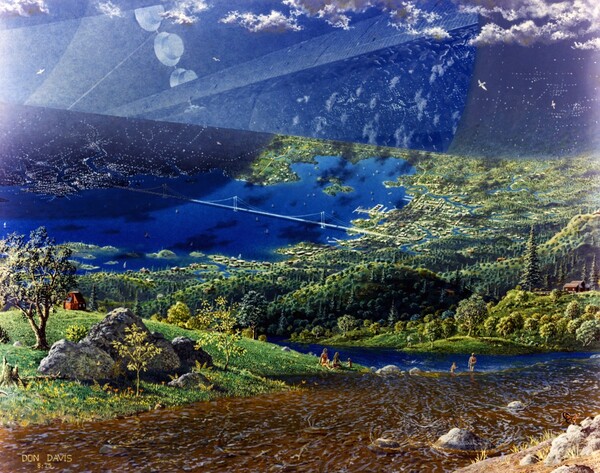This article explores: The environmental impact of O’Neill Cylinders on outer space and the Earth. Find out more about Environmental Impact Of O’Neill Cylinders.
As the potential for human settlement in space becomes increasingly feasible, concepts such as the O’Neill Cylinder have garnered significant attention.

O’Neill Cylinders are self-contained habitats designed to sustain human life in space, offering a potential solution to the challenges of long-term space exploration and colonization.
While the environmental impact of such structures on the space environment is an important consideration, the potential impact on the Earth’s environment has also come under scrutiny.
In this article, we will explore the potential environmental impacts of O’Neill Cylinders on both outer space and the Earth, and examine how these impacts could be managed and minimized to ensure the sustainability and responsible development of these habitats.
How Large Will An O’Neill Cylinder Be?
The size of an O’Neill Cylinder can vary, depending on its intended purpose and the available resources for construction. However, a typical O’Neill Cylinder is envisioned to be quite large, with a diameter of several kilometers and a length of tens of kilometers.
For example, one of the original designs proposed by Gerard O’Neill in the 1970s called for a cylinder with a diameter of about 8 kilometers and a length of 32 kilometers. This design would have been capable of supporting a population of up to 10 million people, as well as providing space for agriculture, industry, and recreation.
Other proposed designs for O’Neill Cylinders have varied in size, but they all share a similar cylindrical shape and rotating design. Some more recent designs have proposed smaller cylinders with diameters of only a few hundred meters, which would be more manageable in terms of construction and maintenance.
Ultimately, the size of an O’Neill Cylinder will depend on a variety of factors, including the intended purpose of the habitat, the available resources for construction, and the technological capabilities of the builders.
How Would An O’Neill Cylinder Effect The Space Environment?
The construction and operation of an O’Neill Cylinder could have various effects on the space environment.
The space environment is characterized by high levels of ionizing radiation from sources such as cosmic rays and solar flares.
The artificial gravity generated by the rotating cylinder could potentially shield inhabitants from some of this radiation. However, the cylinder would need to be designed to provide additional shielding to protect against other sources of radiation.
Here are some potential effects to consider:
Space debris:
One of the primary concerns with any space structure is the potential for collisions with space debris. An O’Neill Cylinder would be located in a low Earth orbit, which is already congested with debris from past space missions. The cylinder itself would also generate debris from maintenance and other activities. Therefore, careful planning and management would be required to minimize the risk of collisions and damage to the structure.
Lighting pollution:
The artificial lighting used to illuminate the interior of the cylinder could potentially cause problems for astronomers on Earth. The bright lights could interfere with telescopes and other observational instruments. To mitigate this effect, the lighting inside the cylinder would need to be carefully designed to minimize light pollution.
Space resources:
The construction of an O’Neill Cylinder would require significant resources, including materials, energy, and labor. These resources would need to be obtained from other parts of the space environment, such as the Moon or nearby asteroids. The extraction and transportation of these resources could have effects on the environment, such as altering the trajectory of asteroids or disrupting the lunar surface.
Radiation exposure:
Overall, the construction and operation of an O’Neill Cylinder would need to be carefully managed to minimize any potential negative effects on the space environment. With careful planning and management, an O’Neill Cylinder could provide a sustainable and self-contained habitat for human life in space.
Would O’Neill Cylinders Have An Environmental Effect On Earth?
It is unlikely that an O’Neill Cylinder would have a direct environmental impact on Earth, as it would be located in space and would not interact with the Earth’s atmosphere or ecosystems.
However, the construction and operation of an O’Neill Cylinder could potentially have indirect environmental effects on Earth. Here are some possibilities to consider:
Resource extraction:
As mentioned earlier, the construction of an O’Neill Cylinder would require significant resources, including materials and energy. These resources would need to be obtained from other parts of the space environment, such as the Moon or nearby asteroids. The extraction and transportation of these resources could have environmental impacts on those locations, although these impacts would be limited in scope compared to terrestrial resource extraction.
Energy consumption:
An O’Neill Cylinder would require a significant amount of energy to operate, especially if it were to be self-sufficient in terms of food production, water recycling, and other essential functions. This energy could come from a variety of sources, such as solar panels or nuclear reactors. The use of nuclear energy could potentially have environmental risks associated with it, such as the possibility of radioactive contamination in the event of an accident.
Space debris:
As mentioned earlier, an O’Neill Cylinder could potentially generate debris that could pose a risk to other objects in space, including satellites and other spacecraft. The debris could potentially fall back to Earth and cause damage or pollution.
Overall, the environmental impact of an O’Neill Cylinder would be relatively minor compared to the impact of human activities on Earth. However, it is important to consider the potential impacts and to manage the construction and operation of an O’Neill Cylinder in a responsible and sustainable manner.
Why Build An O’Neill Cylinder?
An O’Neill Cylinder is a type of space habitat that was originally proposed by physicist Gerard O’Neill in the 1970s as a potential solution to the problem of limited space on Earth and the need for human colonization of space.
The O’Neill Cylinder is a large, rotating cylindrical structure that would provide artificial gravity through centrifugal force and would be able to support human habitation, agriculture, and industry.
There are several reasons why one might want to build an O’Neill Cylinder:
Overpopulation:
Earth’s population is growing at a rapid rate, and there is a limited amount of land available for human habitation. An O’Neill Cylinder would provide a solution to this problem by creating a large amount of living space in a relatively small area.
Colonization:
As humans continue to explore space, the need for habitats that can support long-term human habitation will become increasingly important. O’Neill Cylinders could provide a sustainable solution for human colonization of other planets and moons.
Resource depletion:
As resources on Earth become increasingly scarce, space-based resources could become an important source of raw materials. O’Neill Cylinders could provide a platform for mining and manufacturing in space.
Climate change:
Climate change is a growing concern on Earth, and O’Neill Cylinders could provide a climate-controlled environment for humans to live in. This could be particularly important in the event of a global catastrophe.
An O’Neill Cylinder could provide a self-sustaining, closed ecosystem that would allow humans to live and work in space for extended periods of time.
What Would The Environment Be Like Living In An O’neill Cylinder?
Living in an O’Neill Cylinder would be quite different from living on Earth, but it would provide a unique and potentially exciting experience. Here are some of the key aspects of the environment you would encounter in an O’Neill Cylinder:
Gravity:
One of the defining features of an O’Neill Cylinder is its artificial gravity. The cylinder would rotate around its central axis, creating a centrifugal force that would simulate the effect of gravity. This would mean that you would feel a constant downward pull as you moved around the cylinder, similar to the feeling of being on Earth.
Lighting:
Because the cylinder would be located in space, natural sunlight would not be available. Instead, the interior of the cylinder would be lit by artificial light sources, which could be programmed to simulate day and night cycles.
Climate:
The climate inside the cylinder could be carefully controlled to provide optimal conditions for human habitation. This would include factors such as temperature, humidity, and air quality. Plants would likely play a key role in maintaining the atmosphere inside the cylinder, producing oxygen through photosynthesis.
Views:
Because the cylinder would be a self-contained environment, you would not be able to see the outside world as you can on Earth. However, the interior of the cylinder could be designed to provide stunning views of artificial landscapes, such as gardens, forests, or even cities.
Noise:
With no atmospheric pressure, sound would not propagate in the traditional way we experience on Earth. Therefore, special technologies would be required to simulate sounds within the cylinder.
Overall, living in an O’Neill Cylinder would be a unique and potentially exciting experience. The environment would be carefully controlled to provide optimal living conditions, and the artificial gravity would allow you to move and function much like you would on Earth.
References to “The environmental impact of O’Neill Cylinders on outer space and the Earth”
Here are some important references to consider when exploring the environmental impact of O’Neill Cylinders:
“The High Frontier: Human Colonies in Space” by Gerard K. O’Neill – This book is the seminal work that introduced the concept of the O’Neill Cylinder and sparked a renewed interest in space colonization.
“Space Settlements: A Design Study” by NASA – This report provides a comprehensive overview of the design and construction of space settlements, including O’Neill Cylinders, and includes a discussion of the potential environmental impacts.
“Environmental Implications of Space Debris” by NASA – This report examines the environmental impact of space debris, including the potential impact of debris generated by space structures such as O’Neill Cylinders.
“Environmental Risks and Opportunities in Space Exploration” by the European Space Agency – This report discusses the potential environmental risks and opportunities associated with space exploration and colonization, including the impact of human activities on both the space environment and the Earth’s environment.
“Sustainability in Space: Exploring the Linkages Between Earth and Space” by the Secure World Foundation – This report explores the potential links between sustainability in space and sustainability on Earth, and highlights the need for responsible and sustainable practices in the development of space infrastructure.
By examining these and other relevant references, we can gain a better understanding of the potential environmental impact of O’Neill Cylinders and how these impacts can be managed and minimized to ensure the long-term sustainability of human activities in space.
‘The environmental impact of O’Neill Cylinders on outer space and the Earth’ is one important topic in our series exploring the role of O’Neill Cylinders in space colonization.
Read more about these topics by following the links below:
Republished by Blog Post Promoter
